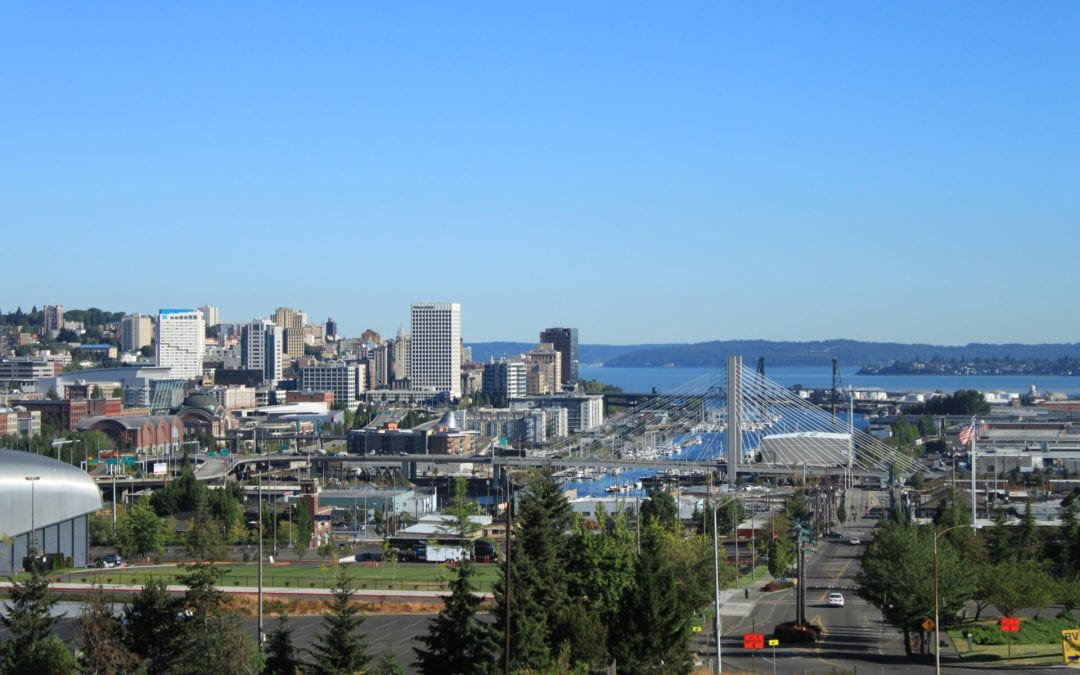Climate Action Plans (CAPs) are comprehensive roadmaps addressing greenhouse gas (GHG) reduction and climate resilience. Local CAPs – those administered by towns, cities, and counties – are integral to addressing climate change. Pursuant to city police power, local governments have both the direct authority and the enabling power to drive policy implementation within their jurisdictions. Additionally, they are often best positioned to assess the climate risks and vulnerabilities relevant to their communities.
While CAPs are popular in cities across the country, this article examines Tacoma, WA, which introduced the city’s CAP in 2008. As Washington’s third largest city, with an estimated population of 220,000, Tacoma functions as the business center of the southern Puget Sound region (with military and healthcare as principal industries) and also hosts a thriving outdoor recreation industry. Specifically, this article focuses on the transportation and land use section of Tacoma’s CAP. Transportation and land use projects are responsible for 44% of Tacoma’s current GHG emissions, and thus represent a big opportunity for Tacoma to reduce emissions and otherwise adapt to our climate future. Tacoma currently faces several climate related challenges. The city’s roads are vulnerable to flood events caused by rising tides, and an increased risk of landslides due to increased rainfall.
Tacoma’s CAP employs several strategies targeting the transportation sector. One initiative calls for improving the existing network of sidewalks, curb ramps, and bike connections by 2050. The update seeks to ensure safe and equitable access to jobs, schools, and services city-wide, and to create healthier and more connected communities. The city plans to fund these improvements through parking-surface taxes, public grants, and the development of a general fund. The city estimates an initial start-up cost of $500,000 and an annual budget of $60,000,000 to meet its 2050 goals.
Both Tacoma’s CAP and the CTR highlight the importance of getting vehicles off the road and increasing active transportation.
Tacoma’s CAP informs other areas of city planning. In 2008, the Tacoma Municipal Code adopted the Commuter Trip Reduction plan (CTR) (Muni Code 551). Like the mobility section of Tacoma’s CAP, CTR seeks to address climate change, air quality, and traffic congestion. To do this, CTR encourages employer-based programs that encourage alternatives to single-passenger car commuting. The plan recommends several measures including providing preferential parking for high-occupancy vehicles, offering subsidies for transit and rail passes, and establishing alternative work-schedule policies. CTR requires quarterly and annual reporting and provides for penalties where employers fail to comply with CTR standards. Both Tacoma’s CAP and the CTR highlight the importance of getting vehicles off the road and increasing active transportation. The program carries the dual benefit of reducing harmful GHG emissions and fostering active, healthy communities.
Additionally, the city’s land use regulatory code seeks to steer new development toward a reduction in GHG emissions (Muni Code 72). For example, applicants for short plat/subdivisions must satisfy a transit access checklist, which shows the location and distance to the nearest bus stops and bus routes, as well as potential transit patronage. Applications must also show existing and planned pedestrian, bike, and vehicle routes that interact with proposed subdivisions. These subdivision requirements seek to reduce GHG emissions and vehicle miles traveled (VMT) by forcing new developments to consider the interplay between public and active transportation with new development in the city. Under the code, subdivision applications can be denied if the applicant fails to satisfy these transportation requirements.
Tacoma’s CAP along with portions of the city’s municipal and land use codes form a loosely coordinated plan to lower GHG and VMT. Where the city’s CAP aims to fund new projects that grow public and active transportation networks, the regulatory codes seek to bend new and existing development toward using those low-carbon transport networks.
CAPs can be especially useful if they channel state climate goals while also informing local planning and regulation.
Tacoma’s planning and regulatory network can be viewed through the IPCC’s CRD framework for sustainable development. CRD considers five factors: mitigation, adaptation, resilience, equity, and enabling conditions. Mitigation is most directly served by Tacoma’s CAP, since building out (and requiring the use of) public and active transport networks directly reduces the number of vehicles – especially single-passenger vehicles – on the road. Fewer vehicles result in lower GHG emissions and VMT. Fortuitously, plans for mitigating GHG and VMT carry positive adaptive effects. Tacoma’s new regulations make infill and higher-density development more likely because more robust transit systems (and regulations that limit sprawl) incentivize centralized development. Compact land use patterns then result in fewer VMT and GHG emissions.
Resilience and equity are also served by the city’s transportation reform. On the one hand, a robust and centralized transit network creates equity by offering the same service to everyone within the city, providing access to vital services like quality food, good jobs, and healthcare. But it also creates resilience because everyone who uses the network maintains a stake in the effective operation of the network. In Tacoma’s case, if there is a disruption to the transit system, residents, employers, and developers are all incentivized to fix the problem, because they all rely on the transit system.
An important enabling condition is support from Washington’s State government. Washington is committed to reducing GHG emissions by 95% by 2050, an ambitious goal that requires collaboration with city governments like Tacoma. The Washington legislature passed the Climate Commitment Act (CCA) which offers guidance and funding to municipalities for projects that reduce GHG emissions. The relationship between local and state government highlights a critical element of climate action. CAPs can be especially useful if they channel state climate goals while also informing local planning and regulation. In conclusion, Tacoma’s CAP provides a framework for building out transportation projects within the city, while also serving as an evolving vision of what modern and climate friendly transportation systems will look like in the 21st century.

